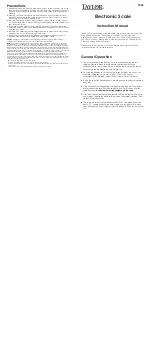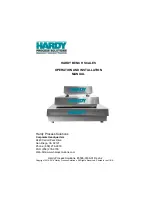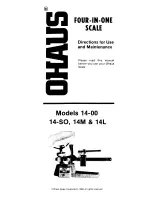
Maintaining proper weight is essential to healthy living.
Obesity has been linked to a higher risk of heart disease,
diabetes and some forms of cancer. The Body Mass Index
(BMI) is the most widely accepted measurement of weight
according to health professionals.
Use the chart below to determine your own BMI by
matching your height in the left hand column with your
weight in the center. Anyone, male or female, with a BMI of
25 to 29 is considered over weight and a body mass index of
30 is considered obese. Remember to eat right and exercise.
In Case of Difficulty...
1.
Place your feet in the same position every time you weigh yourself.
Stand still during measurement.
2.
Weigh yourself without clothing whenever possible. Clothes can vary in
weight.
3.
Move the scale to a location where it won't be bumped. If your scale is
bumped while being activated or while in use, an inaccurate reading
may occur.
4.
For the most consistent readings, weigh yourself at the same time of day.
Allow for weight fluctuations due to food or drink in your system.
5.
“
O_Ld
”
= overload warning
. The maximum capacity of this scale is 330
lbs x 0.2 lb / 150 kgs x 0.1 kg / 23 st 8 lb x ¼ lb. Should “
O_Ld
” appear on
the display during a weighing, this indicates that the maximum weighing
capacity of the scale has been exceeded. Remove the weight
immediately; otherwise, permanent damage may occur.
6.
“
Err
”
= Instability Error
. Ensure the scale is on a flat, stable surface. Step
off and back onto the scale, standing still while your weight computes.
Battery Replacement
Reaching Target Weight
Body Mass Index
Low Battery
Trouble Shooting
1.
Use 1- 3 volt CR2032 lithium battery (as
installed).
2.
Remove screw (or screws) from the battery
compartment cover on the bottom of the
scale and remove the cover. Take care when
removing and replacing the battery door
screw. Do not turn the screw in the wrong
direction or over tighten it as this may strip the
screw threads in the plastic battery door.
3.
Remove the old battery from the
compartment.
4.
Place the new battery with the “+” sign up
into the battery compartment.
5.
Replace the battery compartment cover and
screw(s).
NOTE: Please recycle or dispose of batteries per local regulations.
WARNING: Batteries may pose a choking hazard. As with all small items, do
not let children handle batteries. If swallowed, seek medical attention
immediately.
PRECAUTION: Do not dispose of batteries in fire. Batteries may explode or leak.
Remove the battery if the scale will not be used for a long period of time.
Your Taylor® scale is equipped with a low battery indicator. It will display
“ Lo ”
or readings will grow dim or become irregular if the battery needs
replacement.




















